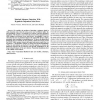Free Online Productivity Tools
i2Speak
i2Symbol
i2OCR
iTex2Img
iWeb2Print
iWeb2Shot
i2Type
iPdf2Split
iPdf2Merge
i2Bopomofo
i2Arabic
i2Style
i2Image
i2PDF
iLatex2Rtf
Sci2ools
TSP
2008
2008
Matched Subspace Detection With Hypothesis Dependent Noise Power
We consider the problem of detecting a subspace signal in white Gaussian noise when the noise power may be different under the null hypothesis--where it is assumed to be known--and the alternative hypothesis. This situation occurs when the presence of the signal of interest (SOI) triggers an increase in the noise power. Accordingly, it may be relevant in the case of a mismatch between the actual SOI subspace and its presumed value, resulting in a modelling error. We derive the generalized likelihood ratio test (GLRT) for the problem at hand and contrast it with the GLRT which assumes known and equal noise power under the two hypotheses. A performance analysis is carried out and the distributions of the two test statistics are derived. From this analysis, we discuss the differences between the two detectors and provide explanations for the improved performance of the new detector. Numerical simulations attest to the validity of the analysis.
| Added | 16 Dec 2010 |
| Updated | 16 Dec 2010 |
| Type | Journal |
| Year | 2008 |
| Where | TSP |
| Authors | François Vincent, Olivier Besson, Cédric Richard |
Comments (0)

